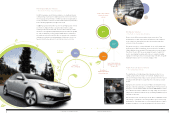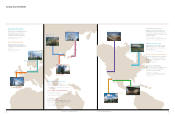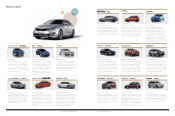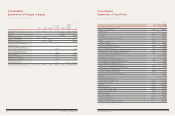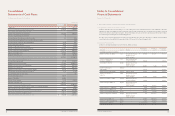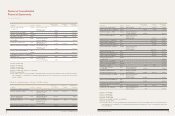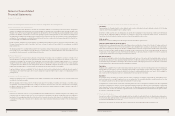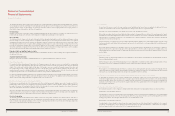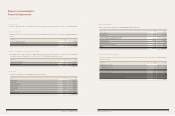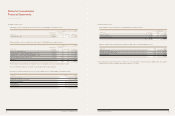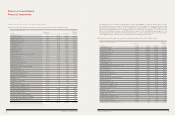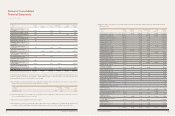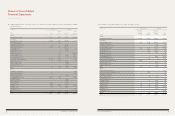Kia 2010 Annual Report Download - page 32
Download and view the complete annual report
Please find page 32 of the 2010 Kia annual report below. You can navigate through the pages in the report by either clicking on the pages listed below, or by using the keyword search tool below to find specific information within the annual report.
The Company’s investments in associates include goodwill identified on the acquisition date (net of any accumulated impairment loss).
Goodwill is calculated as the excess of the acquisition cost of an investment in an associate or subsidiary over the Company’s share
of the fair value of the identifiable net assets acquired. Goodwill is amortized using the straight-line method over its estimated useful life.
Amortization of goodwill is recorded together with equity income (losses).
When events or circumstances indicate that the carrying value of goodwill may not be recoverable, the Company reviews goodwill for
impairment and records any impairment loss immediately in the consolidated statement of income.
The Company’s share of its post-acquisition profits or losses in investments in associates is recognized in the statement of income, and
its share of post-acquisition movements in equity is recognized in equity. The cumulative post-acquisition movements are adjusted
against the carrying amount of each investment. Changes in the carrying amount of an investment resulting from dividends by an associate
or subsidiary are recognized when the associate or subsidiary declares the dividend. When the Company’s share of losses in an associate
or subsidiary equals or exceeds its interest in the associate or subsidiary, including preferred stock or other long term loans and receivables
issued by the associate or subsidiary, the Company does not recognize further losses.
If an associate uses accounting policies or estimates other than those of the Company for like transactions and events in similar
circumstances, the Company makes appropriate adjustments to conform the associate’s accounting policies to those of the Company when
the associate’s financial statements are used by the Company in applying the equity method. However, in the event that accounting
policies and estimates differ due to the application of Exceptions to Accounting for Small and Medium-Sized Entities or Korean International
Financial Reporting Standards (K-IFRS), no adjustments are made.
Unrealized gains on transactions between the Company and its associates are eliminated to the extent of the Company’s interest in each
associate or subsidiary.
(g) Property, Plant and Equipment
Property, plant and equipment are stated at cost, except in the case of revaluations made in accordance with the Asset Revaluation Law,
which allowed for asset revaluation prior to the Law being revoked on December 31, 2000. Assets acquired through investment in kind or
donation is recorded at their fair value upon acquisition.
Significant additions or improvements extending useful lives of assets are capitalized. However, normal maintenance and repairs are
charged to expense as incurred.
Depreciation is computed by using the straight-line method over the estimated useful lives of the assets as follows:
The Company recognizes interest costs and other financial charges on borrowings associated with the production, acquisition, construction
of property, plant and equipment as an expense in the period in which they are incurred.
The Company reviews property, plant and equipment for impairment whenever events or changes in circumstances indicate that the
carrying amount of an asset may not be recoverable. An impairment loss would be recognized when the expected estimated undiscounted
future net cash flows from the use of the asset and its eventual disposal are less than its carrying amount.
Notes to Consolidated
Financial Statements
December 31, 2010 and 2009
Useful lives (years)
Buildings and structures 20-40
Machinery and equipment 15
Dies, molds and tools 5
Vehicles 5
Other equipment 5
As of January 1, 2008, the Company adopted the revaluation model in accordance with the revised Statements of Korea Accounting
Standards (“SKAS”) No.5 Property, Plant and Equipment. The book value of lands is accounted at fair value as of the date of the revaluation
less accumulated impairment loss. If an asset’s book value increases as a result of the revaluation, the amount of the increase is recognized
in other comprehensive income, of which, the amount of the increase that reverses a revaluation decrease of the same asset previously
recognized in profit and loss is recognized in profit and loss in the current period. On the other hand, if an asset’s book value decreases as
a result of the revaluation, that decrease is recognized as a loss for the current period, and the portion of the amount of decrease included
in the credit balance in the revaluation surplus recorded in other comprehensive income is deducted from other comprehensive income.
(h) Leases
The Company classifies and accounts for leases as either operating or capital leases, depending on the terms of the lease. Leases where
the Company assumes substantially all the risks and rewards of ownership are classified as capital leases. All other leases are classified as
operating leases.
Substantially all the risks and rewards of ownership are evidenced when one or more of the criteria listed below are met:
− Ownership of the leased property will transfer to the lessee at the end of the lease term.
− The lessee has a bargain purchase option, and it is reasonably certain at the inception of the lease that the option will be exercised.
− The lease term is equal to 75% or more of the estimated economic useful life of the leased property.
− The present value at the beginning of the lease term of the minimum lease payments equals or exceeds 90% of the fair value of the
leased property.
In addition, if the leased property is specialized to the extent that only the lessee can use it without any major modification, it is considered
a capital lease.
Payments made under operating leases are charged to the statement of income on a straight-line basis over the period of the lease.
Where the Company is a lessee under a capital lease, the present value of future minimum lease payments is capitalized and a
corresponding liability is recognized. In a sale and leaseback contract, the Company recognizes the sale and leaseback transaction,
respectively. However, the Company does not immediately recognize any excess of sales proceeds over the carrying amount as gain, but
defers and amortizes the amount over the lease term.
(i) Goodwill
Goodwill represents the excess of the cost of an acquisition over the fair value of the identifiable net assets acquired. Goodwill is amortized
on a straight-line basis over five years. Where it is no longer probable that goodwill will be recovered from the expected future economic
benefits generated by the acquisition, it is expensed immediately.
(j) Intangible Assets
Intangible assets are stated at cost less accumulated amortization and impairment losses, if any. Impairment losses are determined as the
amount required to reduce the carrying amount of an intangible asset to its recoverable amount.
The criteria for determining whether an incurred cost qualifies as an intangible asset and the periods of amortization for each classification
of intangible asset are described below.
(i) Research and Development Costs
To assess whether an internally generated intangible asset meets the criteria for recognition, the Company classifies the expense
generation process into a research phase and a development phase. All costs incurred during the research phase are expensed as incurred.
Costs incurred during the development phase are recognized as assets only if the following criteria are met for recognition in SKAS No. 3
Intangible Assets: (1) completion of the intangible asset is technically feasible so that it will be available for use or sale; (2) the Company has
the intention and ability to complete the intangible asset and use or sell it; (3) there is evidence that the intangible asset will generate
64 COMPONENTS OF SUSTAINABLE GROWTH 65
KIA MOTORS ANNUAL REPORT 2010


